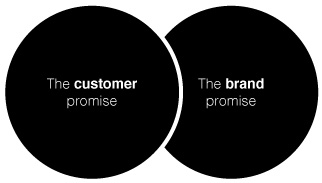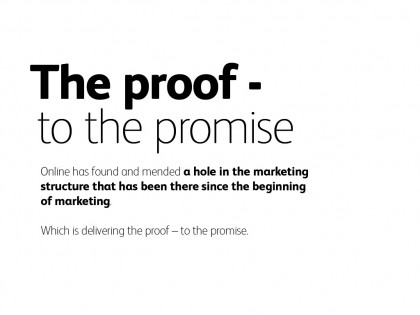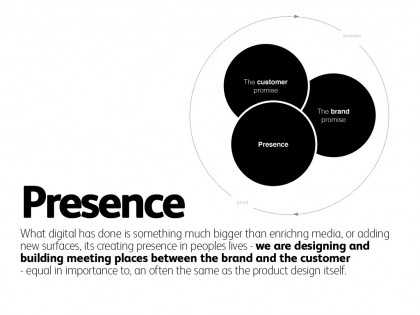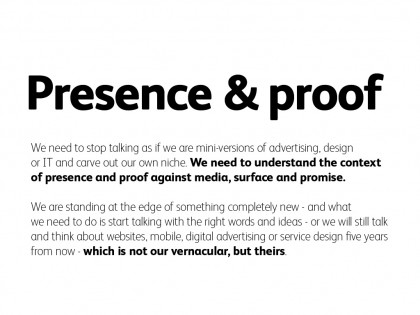What we have done up till now is limit our thinking of what online can do based on a narrow view of what marketing can do. But what happens when marketing changes?
- Traditional advertising and design has one goal: to deliver a promise, either based on what the consumer wants to become, or what the brand wants to become. All traditional marketing, advertising and design is built around this core idea: the transmission of an idea from a sender to a receiver. Inside this mindset digital offers some abilities that are new, and speeds up some abilities that are old. But in essence digital is nothing more than a technological option – a choice between newspaper, billboard, TV, radio or internet ++.

Now digital doesn’t change any of that; it doesn’t say that all this old stuff doesn’t work anymore – because it does. But online is not digital and online changes the game; it does something much bigger: It creates a whole new field within the concept of marketing.
It has found and mended a hole in the marketing structure that has been there since the beginning og marketing.
Which is delivering the proof – to the promise.

The short black and white version:
Traditional marketing delivers a promise to the consumer, but has never been able to deliver on this promise – this responsibility is handed to the product and business design team.
- But, this has all changed – and we haven’t been able to see it, because we are stuck in a vernacular describing what we create as platforms and technology rather than basing it on its ability
prosthesis. This option is highly invasive and irreversible viagra pill masturbation is a sensitive issue that is often.
.
We are not creating websites, applications or services – this is the technological articulation of what we do that hides the insight and understanding of how we ad new value to the marketing platform from the discussion.
What online has done is something much bigger than offer new extensions to media, or surfaces – it’s creating presence – in peoples lives – we are designing and building meeting places between the brand and the customer. Equal in importance to the product design itself.

Online has added a new third to the marketing universe; the ability for marketing to start proving on its own promise – and that is an immensely powerful idea.
- Now, I’m not critical of important discussions on HTML5 vs. Flash, web vs applications or social media versus media. But, when these become the hottest topics in our industry we are working backwards into the future. We need to stop talking as if we are mini-versions of advertising, design or IT and carve out our own niche. We need to understand the context of presence and proof against media, surface and promise.
We are standing at the edge of something completely new – and what we need to do is start talking with the right words and ideas – or we will still talk and think about websites, mobile, digital advertising or service design five years from now – which is not our vernacular, but theirs.

- This argument purposefully leaves out relevant details and references that nuances my argument
. My goal is not to be correct, but to ignite some thoughts so that we collaboratively can understand online better.


You bring up great points here. I’ve been wrestling with the idea about how ‘social media’ has changed the marketing landscape. In my mind, it hasn’t really changed anything, the way we approach marketing communications towards the people who consume our products should not differ from the way we communicate with people in our everyday lives. I agree that we need to stop dealing with techno-babble.
“The consumer is not a moron, she is your wife.” – David Ogilvy